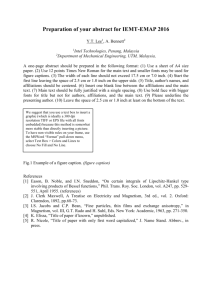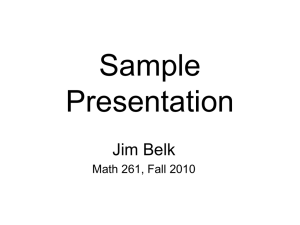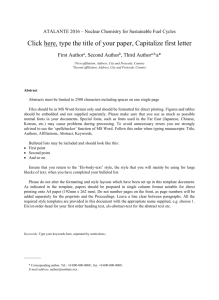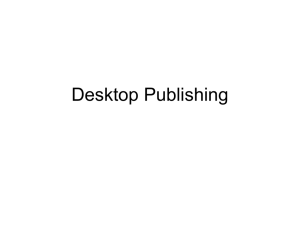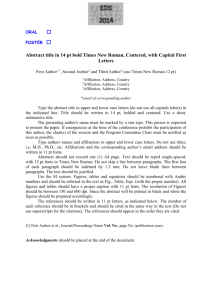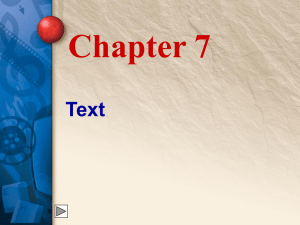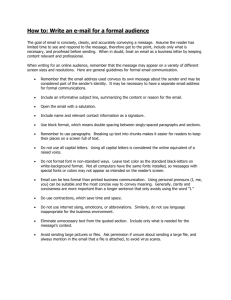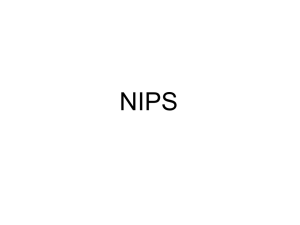nips2015
advertisement
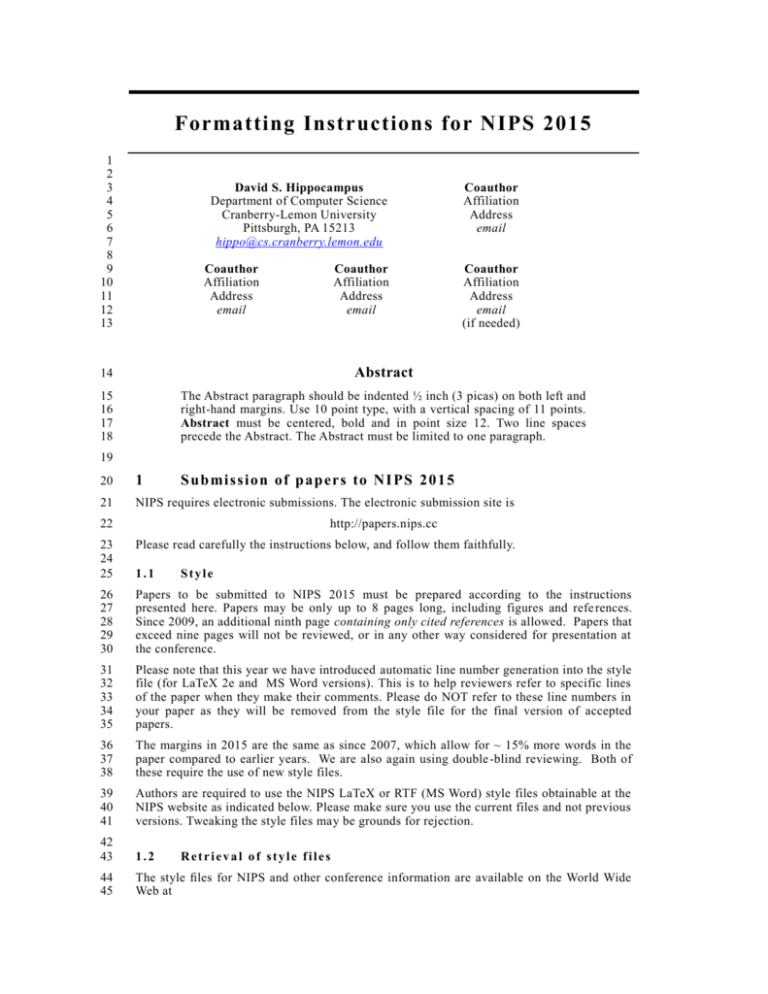
Formatting Instructions for NIPS 2015
1
2
3
4
5
6
7
8
9
10
11
12
13
David S. Hippocampus
Department of Computer Science
Cranberry-Lemon University
Pittsburgh, PA 15213
hippo@cs.cranberry.lemon.edu
Coauthor
Affiliation
Address
email
Coauthor
Affiliation
Address
email
Coauthor
Affiliation
Address
email
Coauthor
Affiliation
Address
email
(if needed)
14
Abstract
15
16
17
18
The Abstract paragraph should be indented ½ inch (3 picas) on both left and
right-hand margins. Use 10 point type, with a vertical spacing of 11 points.
Abstract must be centered, bold and in point size 12. Two line spaces
precede the Abstract. The Abstract must be limited to one paragraph.
19
20
1
S u b mi ssi on of p ap ers to NI PS 2015
21
NIPS requires electronic submissions. The electronic submission site is
22
http://papers.nips.cc
23
24
25
Please read carefully the instructions below, and follow them faithfully.
26
27
28
29
30
Papers to be submitted to NIPS 2015 must be prepared according to the instructions
presented here. Papers may be only up to 8 pages long, including figures and refe rences.
Since 2009, an additional ninth page containing only cited references is allowed. Papers that
exceed nine pages will not be reviewed, or in any other way considered for presentation at
the conference.
31
32
33
34
35
Please note that this year we have introduced automatic line number generation into the style
file (for LaTeX 2e and MS Word versions). This is to help reviewers refer to specific lines
of the paper when they make their comments. Please do NOT refer to these line numbers in
your paper as they will be removed from the style file for the final version of accepted
papers.
36
37
38
The margins in 2015 are the same as since 2007, which allow for ~ 15% more words in the
paper compared to earlier years. We are also again using double -blind reviewing. Both of
these require the use of new style files.
39
40
41
Authors are required to use the NIPS LaTeX or RTF (MS Word) style files obtainable at the
NIPS website as indicated below. Please make sure you use the current files and not previous
versions. Tweaking the style files may be grounds for rejection.
42
43
1.2
44
45
The style files for NIPS and other conference information are available on the World Wide
Web at
1.1
Style
Retrieval of style files
46
http://www.nips.cc/
47
48
49
50
51
52
53
The file nips2015.pdf contains these instructions and illustrates the various formatting
requirements that your NIPS paper must satisfy. LaTeX users can choose between two style
files: nips11submit_09.sty (to be used with LaTeX version 2.09) and
nips11submit_e.sty (to be used with LaTeX2e). The file nips2015.tex may be used as
a “shell” for writing your paper. All you have to do is replace the author, title, abstract and
text of the paper with your own. The file nips2015.rtf is provided as a shell for MS
Word users.
54
55
The formatting instructions contained in these style files are summarized in sections 2, 3,
and 4, below.
56
57
2
58
59
60
61
The text must be confined within a rectangle 5.5 inches (33 picas) wide and 9 inches (54
picas) long. The left margin is 1.5 inches (9 picas). Use 10 point type with a vertical spacing
of 11 points. Times New Roman is the preferred typeface throughout. Paragraphs are
separated by ½ line space, with no indentation.
62
63
64
Paper title is 17 point, initial caps/lower case, bold, centered between 2 horizontal rules. Top
rule is 4 points thick and bottom rule is 1 point thick. Allow ¼ inch space above and below
title to rules. All pages should start 1 inch (6 picas) from the top of the page.
65
66
67
68
69
The version of the paper submitted for review should have "Anonymous Author(s)" as the
author of the paper. For the final version, authors’ names are set in boldface, and each name
is centered above the corresponding address. The lead author’s name is to be listed first (left most), and the co-authors’ names (if different address) are set to follow. If only one co author, list both author and co-author side by side.
70
71
Please pay special attention to the instructions in section 4 regarding figures, tables,
acknowledgements, and references.
72
73
3
74
75
76
First level headings are lower case (except for first word and proper nouns), flush left, bold
and in point size 12. One line space before the first level heading and ½ line space after the
first level heading.
77
78
3.1
79
80
81
Second level headings are lower case (except for first word and proper nouns), flush left,
bold and in point size 10. One line space before the second level heading and ½ line space
after the second level heading.
82
83
3.1.1
84
85
86
Third level headings are lower case (except for first word and proper nouns), flush left, bold
and in point size 10. One line space before the third level heading and ½ line space after the
third level heading.
87
88
4
89
These instructions apply to everyone, regardless of the formatter being used.
90
91
4.1
92
93
94
Citations within the text should be numbered consecutively. The corresponding number is to
appear enclosed in square brackets, such as [1] or [2]-[5]. The corresponding references are
to be listed in the same order at the end of the paper, in the References section. (Note: the
Gen e ral f orma tti n g i n stru cti on s
H ead i n gs: f i rst l evel
Headings: second level
Headings: third level
Ci tati on s, f i gu res, tab l es, ref eren ces
Citations within the text
95
96
standard BibTeX style unsrt produces this.) As to the format of the references themselves,
any standard reference style is acceptable, as long as it is used consistently.
97
98
99
100
As submission is double blind, refer to your own published wo rk in the third person. That
is, use "In the previous work of Jones et al. [4]", not "In our previous work [4]". If you cite
your other papers that are not widely available (e.g. a journal paper under review), use
anonymous author names in the citation, e.g. an author of the form "A.Anonymous".
101
102
4.2
103
104
Indicate footnotes with a number in the text. Place the footnotes at the bottom of the page
on which they appear. Precede the footnote with a horizontal rule of 2 inches (12 picas).
105
106
4.3
107
108
109
110
111
All artwork must be neat, clean, and legible. Lines should be dark enough for purposes of
reproduction; artwork should not be hand drawn. The figure number and caption always
appear after the figure. Place one line space before the figure caption, and one l ine space
after the figure. The figure caption is lower case (except for first word and proper nouns);
figures are numbered consecutively.
112
113
Make sure the figure caption does not get separated from the figure. Leave sufficient space
to avoid splitting the figure and figure caption.
114
115
You may use color figures. However, it is best for the figure captions and the paper body to
make sense if the paper is printed either in black/white or in color.
Footnotes
F i g u re s
116
117
Figure 1: Sample Figure Caption
118
119
4.4
120
121
All tables must be centered, neat, clean and legible. Do not use hand drawn tables. The table
number and title always appear before the table. See Table 1.
122
123
124
Place one line space before the table title, one line space after the table title, and one line
space after the table. The table title must be lower case (except for first word and proper
nouns); tables are numbered consecutively.
Ta b l e s
125
126
Table 1: Sample table title
127
Part
Description
Dendrite
Axon
Soma
Input terminal
Output terminal
Cell Body (contains cell nucleus)
128
129
5
130
131
132
133
Do not change any aspects of the formatting parameters in the style files. In particular, do
not modify the width or length of the rectangle that the text should fit into, and do not
change font sizes (except perhaps in the References section; see below). Please note that
pages should be numbered.
134
Fi n al i n stru cti on s
135
6
136
137
Please prepare PostScript or PDF files with paper size “US Letter,” and not, for example,
“A4.” The -t letter option on dvips will produce US Letter files.
138
139
Fonts were the main cause of problems in the past years. Your PDF file must only contain
Type 1 or Embedded TrueType fonts. Here are a few instructions to achieve this.
140
141
142
143
144
145
146
147
148
149
150
151
152
153
Prep ari n g PostS cri p t or PD F f i l es
You can check which fonts a PDF files uses. In Acrobat Reader, select menu
Files>Document Properties>Fonts and select Show All Fonts. You can also use the
program pdffonts which comes with xpdf and is available out-of-the-box on
most Linux machines.
The IEEE has recommendations for generating PDF files whose fonts are also
acceptable for NIPS. Please see
http://www.emfield.org/icuwb2010/downloads/IEEE-PDF-SpecV32.pdf
LaTeX users:
o Consider directly generating PDF files using pdflatex (especially if you
are a MiKTeX user). PDF figures must be substituted for EPS figures,
however.
o Otherwise, please generate your PostScript and PDF files with the
following commands:
154
o
dvips mypaper.dvi -t letter -Ppdf -G0 -o mypaper.ps
155
o
ps2pdf mypaper.ps mypaper.pdf
156
157
158
159
160
o Check that the PDF files only contains Type 1 fonts.
xfig “patterned” shapes are implemented with bitmap fonts. Use “solid” shapes
instead.
The \bbold package almost always uses bitmap fonts. You can try the equivalent
AMS Fonts with command
161
o
\usepackage[psamsfonts]{amssymb}
162
o
or use the following workaround for reals, natural and complex:
163
o
\newcommand{\RR}{I\!\!R} %real numbers
164
o
\newcommand{\Nat}{I\!\!N} %natural numbers
165
166
167
168
169
170
171
172
173
174
175
176
177
178
179
180
181
182
183
184
o \newcommand{\CC}{I\!\!\!\!C} %complex numbers
Sometimes the problematic fonts are used in figures included in LaTeX files. The
ghostscript program eps2eps is the simplest way to clean such figures. For black
and white figures, slightly better results can be achieved with program potrace.
MSWord 2007 and Windows users (via PDF file):
o Install the Microsoft Save as PDF Office 2007 Add-in from
o http://www.microsoft.com/downloads/details.aspx?displaylang=en&familyi
d=4d951911-3e7e-4ae6-b059-a2e79ed87041
o Select "Save or Publish to PDF" from the Office or File menu
MSWord and Mac OS X users (via PDF file):
o From the print menu, click the PDF drop-down box, and select "Save as
PDF…"
MSWord and Windows users (via PS file):
o To create a new printer on your computer, install the AdobePS printer driver
and the Adobe PostScript Printer Description (PPD) file from
o http://www.adobe.com/support/downloads/detail.jsp?ftpID=204
o Note: You must reboot your PC after installing the AdobePS driver for it to
take effect.
o To produce the ps file, select "Print" from the MS app, choose the installed
AdobePS printer, click on "Properties", click on "Advanced."
o
o
o
o
o
o
o
185
186
187
188
189
190
191
192
193
Set “TrueType Font” to be “Download as Softfont”
Open the “PostScript Options” folder
Select “PostScript Output Option” to be “Optimize for Portability”
Select “TrueType Font Download Option” to be “Outline”
Select “Send PostScript Error Handler” to be “No”
Click “OK” three times, print your file.
Now, use Adobe Acrobat Distiller or ps2pdf to create a PDF file from the
PS file. In Acrobat, check the option “Embed all fonts” if applicable.
194
If your file contains Type 3 fonts or non embedded TrueType fonts, we will ask you to fix it.
195
196
6.1
197
198
199
200
Most of the margin problems come from figures positioned by hand using \special or
other commands. We suggest using the command \includegraphics from the graphicx
package. Always specify the figure width as a multiple of the line width as in the example
below
201
\usepackage[dvips]{graphicx} ...
202
\includegraphics[width=0.8\linewidth]{myfile.eps}
203
or
204
\usepackage[pdftex]{graphicx} ...
205
\includegraphics[width=0.8\linewidth]{myfile.pdf}
206
207
for .pdf graphics.
See section 4.4 in the graphics bundle documentation
(http://www.ctan.org/texarchive/macros/latex/required/graphics/grfguide.ps)
208
209
A number of width problems arise when LaTeX cannot properly hyphenate a line. Please
give LaTeX hyphenation hints using the \- command.
210
A c k n o w l e d g me n t s
211
212
213
Use unnumbered third level headings for the acknowledgments. All acknowledgements go at
the end of the paper. Do not include acknowledgements in the anonymized submission, only
in the final paper.
214
R e f e re n c e s
215
216
217
218
219
References
references.
permissible
Remember
references.
220
221
222
[1] Alexander, J.A. & Mozer, M.C. (1995) Template-based algorithms for connectionist rule
extraction. In G. Tesauro, D. S. Touretzky and T.K. Leen (eds.), Advances in Neural Information
Processing Systems 7, pp. 609-616. Cambridge, MA: MIT Press.
223
224
[2] Bower, J.M. & Beeman, D. (1995) The Book of GENESIS: Exploring Realistic Neural Models with
the GEneral NEural SImulation System. New York: TELOS/Springer-Verlag.
225
226
227
[3] Hasselmo, M.E., Schnell, E. & Barkai, E. (1995) Dynamics of learning and recall at excitatory
recurrent synapses and cholinergic modulation in rat hiippocampal region CA3.
Journal of
Neuroscience 15(7):5249-5262.
M a r g i n s i n L a Te X
follow the acknowledgments. Use unnumbered third level heading for the
Any choice of citation style is acceptable as long as you are consistent. It is
to reduce the font size to ‘small’ (9-point) when listing the references.
that this year you can use a ninth page as long as it contains only cited
